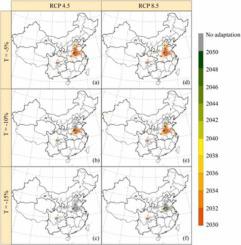European Journal of Agronomy ( IF 5.2 ) Pub Date : 2022-03-16 , DOI: 10.1016/j.eja.2022.126500 Fulu Tao 1, 2, 3 , Liangliang Zhang 4 , Zhao Zhang 4 , Yi Chen 1, 2

|
Wheat has been documented to be vulnerable to climate change in broad regions of the world including China. Adaptation to future climate change by breeding climate resilient cultivars is essential. However the precise information as to where, when, and what cultivar traits should be applied to adapt to climate change in the coming decades has not been available. In this study, we developed novel hybrid assessment models by incorporating a process-based crop model and machine learning algorithms based on a large number of cultivars field experiments data. The models were applied to assess the impact of climate change on wheat productivity and to identify the timescale of wheat cultivar adaptation in the major wheat cultivation regions across China. Wheat yield was projected to decrease on average by 6.3% (9.4%) in the 2050 s under RCP 4.5 (8.5), relative to the baseline period (1986–2005), without the CO2 effect. By contrast, it was projected to increase on average by 5.7% (8.1%) in the 2050 s with the CO2 effect, across the regions and cultivar-maturing traits in China. Solar radiation, precipitation, temperature, cultivar-maturing traits, and CO2 are critical factors affecting wheat productivity in the major wheat cultivation regions. About 44% (39%) and 68% (57%) of wheat planting grids would require cultivar renewal before 2050 (2040) under RCP 4.5 and 8.5 emission scenario, respectively, at a medium risk level without the CO2 effect. The cultivars with a long reproductive growth duration, high photosynthetic efficiency and large harvest index would be generally promising although there are specific traits desirable for certain regions. This study developed a novel framework to identify the precise information on where, when, and what cultivar traits should be applied for wheat to adapt to future climate change, helping the stakeholders to cope with climate change timely and precisely.



























 京公网安备 11010802027423号
京公网安备 11010802027423号